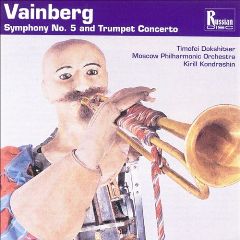Vainberg: Symphony No. 5 - Concerto for Trumpet (1994)
Vainberg: Symphony No. 5 - Concerto for Trumpet (1994)

Symphony No.5 in F minor, Op.76 1. Allegro Moderato 2. Adagio Sostenuto 3. Allegro-Andantino Trumpet Concerto in B flat major, Op.95 4. Etudes-Allegro Molto 5. Episodes-Andante-Fanfares Timofei Dokshitser (trumpet, 4-5) Moscow Philharmonic Orchestra Kirill Kondrashin (conductor, 1-3) Algis Zhiuraitis (conductor, 4-5)
Mieczyslaw Weinberg (more frequently seen in the Russian variant as Moise Vainberg - or ‘Vaynberg’ if you look at the 1980 New Grove) was born in Warsaw, the son of a violinist and composer working in the Polish theatre. In 1941, a fateful year, he moved to the USSR, at first to Minsk, then to Tashkent. His First Symphony resulted in an invitation to Moscow by Shostakovich. The two became close and had a relationship of mutual trust and friendship under which they shared views on draft compositions and supported each other through the most testing of times. Vainberg was in fatal peril in 1953 when his name became linked with a campaign to make a Jewish state out of the Crimea. Shostakovich's intervention saved him from the gulags or a bullet in the back of the head.
The Fifth Symphony has not previously been recorded. The work emerged in 1962 influenced by the first performance, after a long suppression, of Shostakovich's Fourth Symphony. It is dedicated to Kondrashin, a lifelong Vainberg champion, who conducted the premiere of the Shostakovich work and recorded it for Melodiya shortly afterwards. Alistair Wightman comments, in his notes, on the similarities between the music of Shostakovich and Vainberg. The four movement Symphony is indeed bleak, has its moments of soured triumph threaded through with disillusion. There is a beleaguered comfort about the fine tenderly plangent adagio sostenuto which is I think more powerful than anything in Shostakovich 4. It bridges across to the tense adagios of the Roy Harris symphonies of the 1930s and 1940s. Tension bursts the bonds at 9.01 when the tender theme thrusts forward with all the torque of a supercharged spiritual; impressive by anyone's reckoning. The impishly playful flute and then other solo wind instruments seem to dance in macabre delicacy in the shortish allegro. This soon takes on a distinctly Shostakovichian edginess and dazzle before restively petering out into silence from which emerges attacca a pastoral finale. This becomes increasingly impassioned in the raucous style of Markevitch and Mossolov at one point (5.54). All in all this is a deeply serious symphony which hardly ever drops its guard. ---Rob Barnett, musicweb-international.com
Although their number is relatively modest, Weinberg’s concertos still make for a viable overview of his output. Among the most substantial is the Trumpet Concerto, written during 1966–67 and premièred in Moscow on 6 January 1968 by Timofey Dokshitser and the Moscow Philharmonic Orchestra conducted by Kirill Kondrashin. In three movements, this is among the composer’s most diverse works from the period—ranging from pointillist textures invoking the modernist currents then prominent in Soviet music, to elements of the sardonic and the grotesque such as evoke that heady period prior to Socialist Realism. Not for nothing did Shostakovich consider this work a ‘symphony for trumpet and orchestra’.
The first movement, Etudes, opens with nonchalant scales from the soloist which are seconded by the orchestra—the music duly opening out into an animated repartee between these two forces that abounds in rhythmic syncopation and quirky orchestration. A central section is initiated by a more inward response from the soloist against pizzicato strings, and while this soon builds to a hectic dance with percussion to the fore, the soloist responds even more inwardly over a backdrop of muted strings and harp. The initial activity presently continues—soloist and orchestra vying for attention as the scalic writing at the beginning is recalled and the music heads towards a sardonic while undeniably decisive close.
The second movement, Episodes, immediately denotes a greater seriousness of purpose with its intensive polyphonic writing for strings, offset by the wistful tones of a flute whose melodic line is taken up by the soloist (muted), together with upper strings and woodwind. Towards midpoint, the mood intensifies as wind and percussion introduce a martial tone that is assumed imperiously by the soloist, but this is offset by the flute over pizzicato strings in dialogue with the soloist and side-drum stealthily in attendance. The music gradually regains its earlier poise, a repeated gesture from the soloist sounding ominously before, over a quiet pedal-point, flute then piccolo and harp effect a calmly expectant close.
The third movement, Fanfares, ensues without pause—the soloist’s repeated gesture proving to have Mendelssohnian overtones, which are continued with echoes of Rimsky-Korsakov and Stravinsky among others. An elaborate cadenza unfolds, accompanied in the main by woodblock and side drum, which leads into an obliquely elegant dialogue where the soloist is partnered by a succession of solo wind, string and percussion—all the while making reference back to the handful of quotes heard at the beginning. Towards the close the soloist touches musingly upon the scales heard at the work’s very opening, before this most unlikely of finales is rounded off by a single conclusive chord from percussion. ---Richard Whitehouse, naxos.com
download (mp3 @320 kbs):
yandex 4shared mega mediafire zalivalka cloudmailru uplea








